Ornate Wobbegong
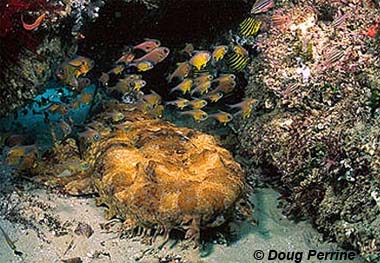
Orectolobus ornatus
This type of carpet shark has a flat head and stocky body with a stout tail. It has nasal barbels and dermal lobes forming a fringe along the front of its face (Compagno 2001) and is usually a golden brown with dark broad saddles (Compagno 2005). A nocturnal hunter, it prefers bays and shallow reefs (Huveneers et al., 2015), and because of its markings and its daytime sluggishness, it is easy for unexpected human encounters to result in bites.
Order: Orectolobiformes
Family: Orectolobidae
Genus: Orectolobus
Species: ornatus
Common Names
- English: ornate wobbegong, banded wobbegong, carpet shark, and gulf wobbegong.
- Danish: stribet wobbegong.
- Dutch: sierlijke bakerhaai.
- Finnish:
- French: requin-tapis paste.
- Japanese: karakusa-ôse.
- Spanish: tapicero ornamentado.
- Swedish: brokig wobbegong.
Importance to Humans
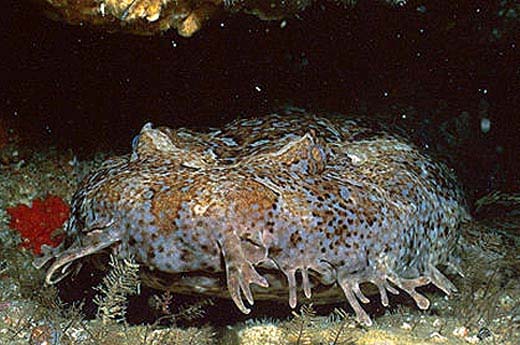
There is currently limited interest in the ornate wobbegong by both commercial and recreational fisheries, in part due to management regulations and their small size. It does face some threat from commercial fisheries in eastern Australia and New South Wales, where they can be both a target species or taken as bycatch. The flesh of this wobbegong is sometimes marketed locally and there is no known demand for their fins. However, the skin has historically been used for making leather due to its toughness and attractive coloration (Huveneers et al., 2015).
Danger to Humans
The ornate wobbegong can inflict shallow but painful wounds with its sharp anterior teeth if harassed or attacked. It has also been known to swim towards nearby divers in a possibly antagonistic response (Compagno 2001). Ornate wobbegongs have also been known to bite waders and fishers in tidepools (Compagno 2001). Humans should take care when present in areas where this wobbegong lives as its camouflage coloration can hide this fish quite well from the unwary. According to the International Shark Attack File, there have been 32 attacks attributed to wobbegong species. Due to the similarity of wobbegong species, it is often difficult for an accurate identification.
Conservation
This wobbegong is considered of “Least Concern” by the World Conservation Union (IUCN). Size and daily trip regulations reduced targeting of this species and there is no evidence suggesting current population decline (Huveneers et al., 2015).
In areas outside of Australian waters, there is some concern for the ornate wobbegong due to habitat degradation and unregulated fisheries (Compagno 2001).
> Check the status of the ornate wobbegang at the IUCN website.
The IUCN consists of a global union of state, governmental agencies, and non-governmental organizations in partnership whose goal is to assess the conservation status of different species.
Geographical Distribution
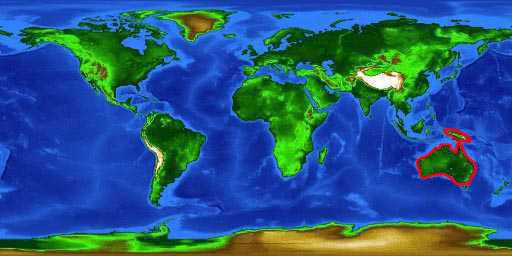
The distribution range of the ornate wobbegong is limited to the western Pacific Ocean. Sources such as Compagno (2001) describe their range as including Indonesia, Papua New Guinea, and Japan, but there is some concern that they have been misidentified in these locations (Huveneers et al., 2015). They are known to be regularly found on the coastlines of Australia (Huveneers et al., 2015).
Habitat
It is a tropical species and associated with bays, algal-covered rocky bottoms, and coral reefs of inshore waters from depths of 0-100 m (0-328 ft.) (Compagno 2005). Habitat selection does not seem to be tied to the abundance of prey and may instead be a product of predator avoidance (Huveneers et al., 2015). The ornate wobbegong seeks prey and is active at night while during the day it is often observed resting on the bottom (Compagno 2005). It prefers clearer water than does its close relative, the spotted wobbegong (Orectolobus maculatus) (Compagno 2005).
Biology
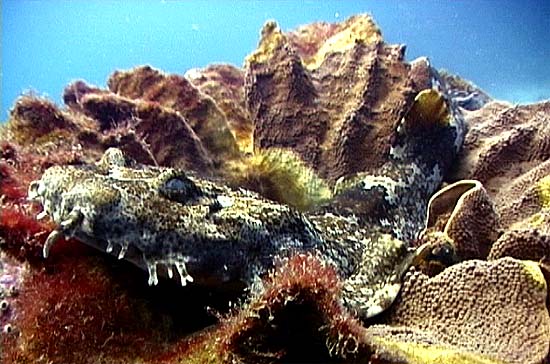
Distinctive Features
The ornate wobbegong has a broad, flattened head with small oval eyes and well-developed spiracles. There are skin flaps (nasal barbels) with a few branches located around the margins of the snout and a symphysial groove on the chin (Compagno 2001). Five dermal lobes are present below and in front of each eye (Compagno 2001). It has two large dorsal fins that are nearly equal in sized and triangular. The first dorsal fin is located over the pelvic fin base and the second dorsal fin insertion is anterior to the anal fin origin (Huveneers et al., 2006). The anal fin is rounded and located so far posteriorly, that it looks similar to the lower caudal fin lobe (McGrouther 2014). The caudal fin has a long upper lobe that is hardly elevated above the axis of the body. There is a strong terminal lobe and subterminal notch (Compagno 1998).
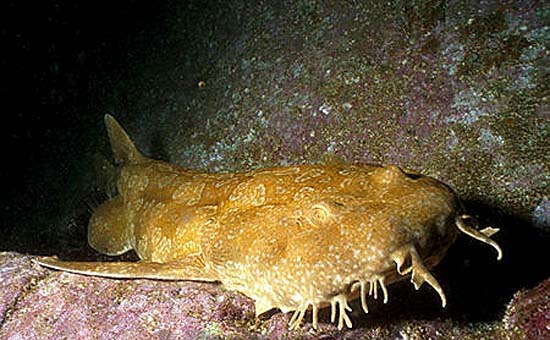
Sometimes confused with the ornate wobbegong, the spotted wobbegong O.maculatus can be distinguished by the dark saddles and indistinct circles formed by groupings of small white dots (McGrouther 2014).
Coloration
Typically golden-brown in color, the ornate wobbegong has conspicuous dark rectangular saddles (Compagno 2005). The lighter spaces between these saddles have dark, light-centered spots but not ocellate in appearance (Compagno 2001). This ventral surface is pale in color. The fin margins often have dark spots (McGrouther 2014).
Dentition
The ornate wobbegong is an ambush predator that possesses long teeth lacking lateral cusplets. There are two long and sharply pointed teeth in the upper jaw and three in the lower jaw (Compagno 2001).
Denticles
There are nasal barbels along with a few branches located near the snout of the ornate wobbegong (Compagno 2005). Five dermal lobes are present below and anterior to each eye, dermal lobes located behind the spiracles are either unbranched or weakly branched and broad (Compagno 2005). Dermal tubercles and ridges are absent on the back of this wobbegong (Compagno 2001).
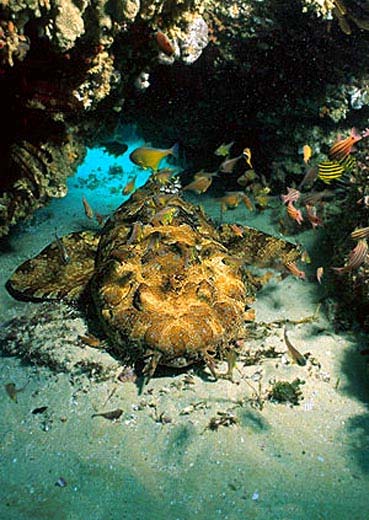
Size, Age, and Growth
The maximum reported size of the ornate wobbegong is 120 cm (3.9 ft) total length, however this measure was previously thought higher due to misattribution with another wobbegong (Huveneers et al., 2015). The ornate wobbegong reaches maturity at approximately 80 cm (2.6 ft) total length and size at birth is about 20 cm (7.9 in) in length (Huveneers et al., 2015).
Reproduction
The ornate wobbegong is an ovoviviparous species meaning that the embryos feed initially on yolk stores, but then can gain nutrients from other sources. The ornate wobbegong is considered either strict lecithotrophic or incipient histotrophic viviparous. In the first case, the yolk would provide all embryonic nutrition and in the second a small quantity of nutrients would be supplied by uterine secretions (Huveneers et al., 2011). The ornate wobbegong gives live birth to at least 12 pups per litter with each measuring approximately 20 cm (7.9 in) in total length (Compagno 2005). The gestation period is approximately 10-11 months with pups born in September or October (Huveneers et al., 2015).
Food Habits
Bony fish are the most common prey item, particularly green moray, snapper, and blackfish (Huveneers et al., 2007). They also feed prominently on cephalopods (Huveneers et al., 2007) as well as on some crustaceans, sharks, and rays (Compagno 2001). The ornate wobbegong uses a sit-and-wait ambush strategy that relies on its camouflage coloration pattern and lure of its dermal flaps to trick potential prey into its range (Michael 2005). When a prey item does come within range, the wobbegong ambushes it with a quick snap of its jaws. However, wobbegongs have also been seen actively chasing prey and the ornate wobbegong may employ this strategy as well (Huveneers et al. 2007).
Predators
Any large fish or marine mammals are potential predators.
Parasites
A species of cestode, Stragulorhynchus orectologi n. g., n. sp., has been documented as a parasite of the ornate wobbegong (Beveridge 1987).
Taxonomy
The ornate wobbegong was originally described as Crossorhinus ornatus by De Vis in 1883. This name was later changed to the currently valid Orectolobus ornatus (De Vis 1883). The genus name, Orectolobus, is derived from Greek ‘orektos’ meaning stretch out and ‘lobos’ meaning lobe. Synonyms referring to this species in past scientific literature include Orectolobus devisi Ogilby 1916.
A subspecies, Orectolobus ornatus halei, from South Australia was proposed by Whitley (1940). It can be distinguished from the ornate wobbegong by differences in coloration patterns, smaller adult size, and fewer dermal lobes on the head. O. ornatus halei also has a longer pelvic fin to anal fin interspace, smaller pectoral fins and relatively smaller claspers in mature specimens. However it remains to be determined at what level these apparent differences can be recognized and if this is truly a subspecies of the ornate wobbegong.
Revised by: Tyler Bowling and Jennifer Dorrian 2019
Prepared by: Cathleen Bester
References
- Compagno, L.J.V., Dando, M. and Fowler, S., 2005. A Field Guide to the Sharks of the World Harper-Collins.
- Compagno, L.J., 2001. Sharks of the world. An annotated and illustrated catalogue of shark species known to date, vol 2. Bullhead, mackerel and carpet sharks (Heterodontiformes, Lamniformes and Orectolobiformes). FAO species catalogue for fishery purposes, 1, pp.viii+-1.
- Huveneers, C., Pollard, D.A., Gordon, I., Flaherty, A.A. and Pogonoski, J., 2015. Orectolobus ornatus. The IUCN Red List of Threatened Species 2015: e.T41838A68638906. http://dx.doi.org/10.2305/IUCN.UK.2015-4.RLTS.T41838A68638906.en
- Huveneers, C., Otway, N.M., Harcourt, R.G. and Ellis, M., 2011. Quantification of the maternal–embryonal nutritional relationship of elasmobranchs: case study of wobbegong sharks (genus Orectolobus). Journal of fish biology, 78(5), pp.1375-1389.
- Huveneers, C., Otway, N.M., Gibbs, S.E. and Harcourt, R.G., 2007. Quantitative diet assessment of wobbegong sharks (genus Orectolobus) in New South Wales, Australia. ICES Journal of Marine Science, 64(6), pp.1272-1281.
- Michael, S.W., 2005. Reef sharks and rays of the world. ProStar Publications.
- McGrouther, M., 2014. Banded Wobbegong, Orectolobus ornatus (De Vis , 1883), Australian Museum. Available from: https://australianmuseum.net.au/banded-wobbegong-orectolobus-ornatus-de-vis-1883.